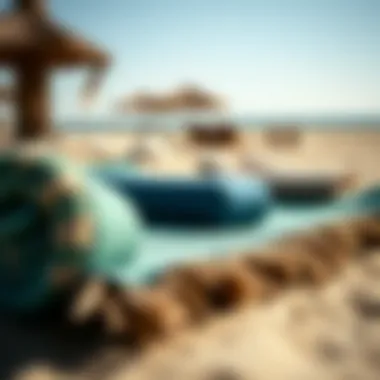Ultimate Guide to Choosing the Best Portable Beach Mats


Intro
When the sun is shining, and the waves are lapping at the shore, there's no better companion than a portable beach mat. These handy items are more than just a place to sit; they serve as a crucial element in elevating your beach experience. In this guide, we will explore the ins and outs of portable beach mats, covering everything from their design to functionality, and even maintenance tips. Whether you're a beach enthusiast or someone who enjoys occasional seaside getaways, knowing the details about these mats can help enhance your relaxation.
A key aspect of choosing the right beach mat lies in understanding the various materials available. There's a world of options out there, from lightweight nylon to plush cotton. Each material comes with its own set of advantages and disadvantages, which we will break down thoroughly. This comprehensive examination enables readers to make informed decisions tailored to their specific needs. Furthermore, we will delve into innovative features and eco-friendly considerations, providing a holistic approach to selecting your ideal beach accessory.
As we navigate through this guide, we aim to equip you with valuable insights that can transform mundane beach days into unforgettable experiences. Let’s sift through this sandy topic together.
Intro to Portable Beach Mats
When imagining a perfect day at the beach, many people envision soft sand underfoot, a gentle breeze, and the sun warming their skin. However, to truly enjoy this paradise, having the right gear is crucial. This is where portable beach mats come into play. They provide a comfortable and clean surface to sit or lie on, enhancing the overall beach experience.
Portable beach mats are more than just fabric slapped together; they are meticulously designed products that cater to the various needs of beach-goers. They often come in different sizes, materials, and styles, making them versatile for any beach outing. For those who relish a day under the sun or by the waves, selecting the right beach mat can lead to more enjoyable hours spent by the shore.
Defining Portable Beach Mats
A portable beach mat is a specialized piece of outdoor gear, designed to offer comfort and convenience at beach locations. Primarily, they serve to elevate individuals above hot sand, providing a buffer from heat, moisture, and dirt. While they may look like basic cloth coverings, these mats can possess varying degrees of water resistance and even UV protection depending on the material and design used.
It's essential to think of them as both a necessity and a luxury. Not only do they protect against dampness and grit, but they also create a personal space on crowded beaches. The portability aspect means that they are lightweight and easy to carry, perfect for spontaneous trips to the seaside, whether it's a quick jaunt or a day-long affair. Thus, they embody functionality while enhancing one's outdoor experience.
Key Features to Consider
When assessing portable beach mats, several key features warrant attention:
- Material Composition: The fabric can greatly influence comfort and durability. Materials like polyester and nylon are common, but eco-friendly options are also emerging.
- Size Options: Depending on whether you're lounging solo or with family, the size can vary.
- Portability: Features like foldability or the inclusion of carrying straps can add to its ease of use.
- Water Resistance: Some mats repel water or dry quickly, which is a great feature for wet conditions.
- Resistance to Fading: Sun exposure can add years of wear to textiles; look for options designed to withstand UV rays.
- Cleaning Ease: Sand can cling to fabrics; mats that can be wiped clean or washed easily are preferable.
By carefully considering these factors, shoppers can find a beach mat that suits their lifestyle and enhances their time spent in the sun.
Types of Portable Beach Mats
When it comes to making the most of a day at the beach, the kind of mat you choose can play a significant role. Understanding the types of portable beach mats available not only helps in selecting the right one for your needs but also enhances your overall beach experience. Different mats cater to various situations, whether you’re looking for comfort, portability, or protection from the elements. Below, we dive into three primary types of beach mats: traditional fabric mats, inflatable mats, and waterproof mats, exploring each type's unique attributes and considerations.
Traditional Fabric Mats
Traditional fabric mats are often the go-to choice for many beach enthusiasts. Constructed from materials such as cotton or polyester, these mats offer a soft surface to sit on while absorbing some moisture.
- Breathability: One of the standout benefits of fabric mats is their breathability. They allow air circulation, making them less stifling on hot days.
- Easy to Clean: Most fabric mats can be easily washed with soap and water, should they fall victim to sand or spills.
- Variety of Designs: They come in a wide array of colors and patterns, appealing to different tastes and styles.
Consideration: However, traditional fabric mats can absorb water, which might make them damp on humid days. They also tend to be heavier and bulkier compared to other types. So, if you’re lugging these along with beach gear, they can add a bit of weight.
Inflatable Mats
Inflatable mats have surged in popularity recently, thanks to their lightweight nature and compact design. These mats are perfect for those who want comfort without the burden of extra weight.
- Portability: Their inflatable design allows them to deflate and roll up into a small package, making them easy to stow away in a bag.
- Comfort: With air-filled structures, these mats provide excellent cushioning, offering a comfy space to kick back and relax.
- Versatility: Many inflatable mats are designed for both beach and pool use, extending their functionality.
"Inflatable mats bring a world of comfort to your sandy haven, transforming the rough terrain into a plush experience."
Consideration: The need to inflate and deflate can be a bit of a chore, especially if you're eager to hit the waves. Furthermore, punctures can be a concern, leading to potential deflation mid-use.
Waterproof Mats
As the name suggests, waterproof mats are built to resist moisture, making them an attractive option for those who prefer to stay dry.
- Water Resistance: They prevent water from soaking through, making them ideal for moist sand or after a dip in the ocean.
- Durability: Typically made from synthetic materials, waterproof mats can withstand harsh conditions and are generally more resistant to wear and tear.
- Quick Drying: After your beach day, these mats are often designed to dry quickly, which is a plus if you're heading somewhere else after.
Consideration: While waterproof mats excel in terms of moisture management, they might lack the plush feel that fabric or inflatable options offer. For comfort-seekers, this could be a downside, especially during prolonged lounging.
Choosing the right type of beach mat boils down to personal preference, intended use, and individual needs. Each type holds its own advantages and disadvantages, so weighing the options carefully can significantly impact your enjoyment at the beach.
Materials Used in Beach Mats
Understanding the materials used in beach mats is crucial for anyone looking to make a wise purchase. The right fabric not only determines comfort but also influences the durability and functionality of the mat. Each type of material comes with its unique set of benefits and considerations that can significantly enhance the beach experience. As the sun beats down and sand is whisked away by the salt breeze, the material of your beach mat will dictate how well it performs in such conditions.
Cotton and Polyester
When it comes to traditional beach mats, cotton and polyester are the heavyweights of the textile world. Cotton is known for its softness, making it a favorite among beach-goers who prefer comfort underfoot. It absorbs moisture well, which can be a double-edged sword; while it feels good to lay on, it’ll take its sweet time to dry when the inevitable wave splashes come along. Nevertheless, if you prefer lounging and reading, a cotton mat could turn your beach day into a mini-vacation.


On the other hand, polyester ramps up the durability factor. This synthetic material boasts weather resistance and dries quicker than cotton. Polyester’s lightness makes it easy to carry, a big plus for those who plan to trek across the sand. However, it may become less breathable on a sweltering day, causing a sweaty backside.
In summary: If you’re after coziness, go cotton. If you want lightweight and fast-drying, polyester is the way to go.
Nylon Options
Nylon is another popular choice, especially for those in search of robust beach mats. Often regarded as a workhorse material, nylon is incredibly strong and tear-resistant, making it ideal for high-traffic beach areas. It can withstand harsh conditions—think toddlers playing, dogs running around, and any general wear and tear. Not only that, but many nylon mats come with a water-resistant coating, adding an extra layer of protection against spills and moisture.
While nylon brings favorable strength and durability, it does have its pitfalls. First off, it can be less soft than cotton or even polyester, which might detract from the comfort factor during a long sunbathing session. Also, as it tends to heat up under direct sunlight, you might find yourself doing the hot-foot dance as you rush to lay down your towel.
Essentially: Go for nylon if durability is your main jam, but be cautious about its texture and heat retention.
Eco-friendly Materials
In an era where sustainability is more than just a buzzword, eco-friendly materials are becoming increasingly popular in the design of beach mats. From recycled plastics to organic fabrics, these materials not only reduce environmental impact but also provide unique features that can boost the beach experience. For instance, mats made from recycled materials might come with additional sun protection features, optimizing their lifespan.
Furthermore, organic cotton is often grown without harmful pesticides, contributing positively to not just our environment but also to the health of those using the mats. Another trending option is bamboo, known for its quick growth and renewability. Although slightly less common than others, bamboo mats offer a luxurious feel and are biodegradable at the end of their life cycle, making them a solid choice for the eco-conscious.
"Choosing a mat made from eco-friendly materials can reduce your carbon footprint while enhancing your beach outings."
To sum things up: When looking to minimize environmental impact, consider eco-friendly options that benefit both you and the planet.
Size and Portability Considerations
When it comes to beach outings, size and portability of your beach mat can’t be overlooked. They are pivotal in determining your comfort while lounging on the sand and the ease of transport to and from the beach. A mat that is too large may take up precious space in the trunk or beach bag, while one that is too small might leave you feeling cramped and uncomfortable. Therefore, understanding the balance between size and portability is crucial in making an informed decision.
This section dives into two crucial facets: choosing the right size and weight and foldability. By addressing these elements, you can ensure that your beach mat not only enhances your experience but also meets your travel needs seamlessly.
Choosing the Right Size
Selecting the proper size for your beach mat involves more than just checking dimensions. Consider the number of people who will be using it, as well as the activities planned for your beach day. A solo adventurer might get away with a compact mat, while a family with kids might need a larger surface to spread out towels, snacks, and toys. Here are some key points to keep in mind:
- Capacity Needs: Make sure to account for the number of people, plus some extra space for comfort. If you're planning to share your mat, an oversized option will give everyone room without feeling cramped.
- Activities in Mind: If you plan on practicing yoga, simple stretching movements, or even sunbathing, a larger mat would be more suitable. Conversely, if you just need a little patch to sit, a smaller option suffices.
- Location of Usage: Area matters, too. Some beaches are rocky and uneven, needing a mat to be wide enough to safely sit on. Others might be flat and soft, allowing for smaller choices without compromise.
- Storage Space: Finally, consider your vehicle or how far you need to carry the mat. If you’re taking public transport or hiking to the beach, a smaller size might be preferable.
Weight and Foldability
The weight and foldability of a beach mat play a significant role in its ease of transportation. An ideal mat strikes a balance between being light enough to carry easily and sturdy enough to withstand outdoor conditions. It should be manageable even when fully packed with towels and gear. Here are some considerations:
- Weight: A lightweight mat means less strain while carrying it to the beach. Look for materials like nylon or polyester that often offer a balance between durability and weight.
- Foldability: How a mat folds is also key. Most mats can be folded, rolled, or even stuffed into bags. Opt for a mat that takes up minimal space when not in use. Easier foldability means quicker pack-up time when it’s time to hit the road.
- Carrying Options: Some mats come with shoulder straps or carry handles, making them easier to transport. If you plan on walking a distance, this added feature can make all the difference.
- Compact Design: Many modern beach mats are designed to compress down, which can be handy when storage spaces are limited. Compact options fit easily into backpacks or car trunks, ensuring you don’t feel burdened on the way to your beach paradise.
Evaluating Comfort and Support
When it comes to enjoying a day at the beach, comfort is paramount. Evaluating comfort and support in portable beach mats is essential as these factors can greatly influence your overall beach experience. Whether you're lounging with a book, playing beach volleyball, or simply soaking in some rays, the right mat can make all the difference. The advantages of choosing a comfortable mat not only enhance relaxation but also support your body adequately, preventing discomfort during prolonged use.
A good beach mat should provide cushioning and insulation from the hard, uneven ground. Think of it like eating a cookies and cream sundae; you want the perfect balance of flavors and textures to elevate your taste experience. The same principle applies to your mat—each element contributes to making your time by the sea much more enjoyable.
Cushioning Features
Cushioning features play a significant role in determining how cozy your beach mat will be. Typically, mats with thick foam or gel padding offer superior cushioning. Some of these mats are designed to absorb impact, allowing you to sit or lie down without feeling every grain of sand or pebble underneath you. This is particularly important for those who plan to spend extended time in one spot outside.
Higher-quality mats may include additional layers or special materials that enhance comfort. Consider looking for options that provide good stability while also being soft to the touch. For example, some mats utilize memory foam technology, allowing it to contour to your body shape while also regaining its original form after use. This ensures maximum comfort without losing structure.
A few additional thoughts:
- Look for dual-layer designs that combine lightweight materials with padded support.
- Check for the manufacturer’s specifications regarding the density of the foam. A denser mat usually results in better comfort and support.
Thermal Insulation
Thermal insulation is another aspect that should not be overlooked when evaluating beach mats. Beaches often get hot, and lying directly on the sand can lead to discomfort from heat exposure. A well-insulated mat can keep your body cool while you relax during those sweltering summer days.
Many beach mats are designed with thermal barriers to reflect heat or insulate against the warmth of hot sand. Materials such as closed-cell foam or special reflective fabric help maintain a comfortable surface temperature. Some mats even feature cooling gel layers that not only provide the padding but also actively work to lower your surface heat.
When choosing a mat, consider the thermal performance of the materials used. It’s worthwhile to inquire whether they keep cooler on sunny days or whether they quickly absorb heat from the ground below.
In summary, comfort and support should not be afterthoughts when selecting a portable beach mat. Cushioning features enhance your relaxation while thermal insulation ensures a pleasant surface temperature, paving the way for an enjoyable beach day.
Remember, when it comes to beach mats, comfort is king, and the right choice can transform a day on the sand into a blissful experience.


For more tips on sustainable beach practices, visit EPA.gov and dive into their resources on eco-friendly options.
Durability and Weather Resistance
When it comes to portable beach mats, durability and weather resistance aren't just buzzwords; they’re crucial attributes that can make or break your beach experience. A high-quality mat needs to withstand the rigors of sandy terrains, salty ocean air, and variable weather conditions. Let's delve deeper into these vital factors that help in choosing the right beach mat for your needs.
Evaluating Material Durability
Material durability plays a significant role in ensuring your beach mat remains functional over time. You wouldn't want to invest in a mat that frays after a couple of outings or becomes unusable after a brief rain. Here are some materials known for their durability:
- Ripstop Nylon: This material is incredibly tough and tear-resistant, making it a popular choice for beach mats. It doesn’t just hold its own against rough surfaces but can also be easily cleaned.
- Polyester: While generally lighter than nylon, polyester still holds up well against wear and tear. It resists fading and can withstand sunlight pretty effectively, which brings us to our next consideration.
- PVC Coated Fabrics: Sometimes used for waterproof mats, this material is excellent for resisting moisture. It's easy to wipe clean, but it’s heavier and not as breathable, which might be a concern in hot conditions.
When exploring durability, think of scenarios. If your beach outings involve kids and pets, a mat made from heavy-duty nylon could be advantageous as it withstands rough use.
Resistance to Sun Damage
Since most beach trips happen under the glaring sun, it's paramount to consider how a mat stands up against UV rays. Sun damage can lead to fading, loss of structural integrity, and functional decline. Not all fabrics are made equal in this regard.
- UV-Resistant Fabrics: Seek out mats expressly labeled as UV resistant. These materials have undergone treatments to withstand prolonged sun exposure, helping to retain their color and strength.
- Color Choices: Darker colors tend to absorb heat and may fade quicker under intense sunlight. Opting for lighter shades not only keeps the mat cooler but can also reduce the risk of fading.
- Protective Coatings: Some mats come with protective finishes that bolster their resistance against UV rays. Double-check the product specifications before you make a purchase.
When you choose a beach mat, consider future use. A durable mat that resists sun damage will serve you well over time, making beach outings a consistent pleasure.
In summary, focusing on durability and weather resistance when picking out a beach mat can save you time, money, and frustration in the long run. Look for proven materials and protective features to ensure that your mat stands up to the elements, so your beach days can be about relaxation rather than repair.
Innovative Features in Modern Beach Mats
As beach mat technology evolves, manufacturers are incorporating innovative features that enhance usability and comfort. These improvements cater to the needs of today’s beachgoers. Modern beach mats aren’t just simple pieces of fabric anymore; they come loaded with conveniences that make your seaside experience significantly better. Understanding these innovations can help you choose a mat that truly suits your style and requirements.
Integrated Storage Solutions
One of the most sought-after features in contemporary beach mats is integrated storage. Gone are the days when you had to juggle bags while trying to lay down your mat. Manufacturers are now including pockets, zipped compartments, and even insulated cooler sections within the design of the mat itself.
Using these integrated storage solutions brings a world of benefits:
- Organization: Everything from sunscreen to snacks can have its place, reducing clutter on your beach outing.
- Convenience: Having quick access to your essentials without getting up is a boon when you're sunbathing or lounging.
- Safety: With built-in storage, you can lower the risk of leaving valuables unattended on the sand.
For example, some mats feature waterproof pockets perfect for keeping devices dry while you're splashing about in the waves. You can tuck your phone away, knowing it'll stay safe from waves or rogue water balloons.
Adjustable Anchoring Systems
Another game-changer is the adjustable anchoring system, which ensures your mat stays put regardless of the wind. Traditional methods often leave your mat flying across the beach like a runaway kite. Modern designs now include stakes, sand pockets, or tethering systems that allow you to secure your mat effectively.
These anchoring methods offer several advantages:
- Stability: No more chasing after your mat as a gust of wind attempts to turn it into a sail.
- Adjustability: Many designs allow you to customize the anchoring based on the conditions. If you’re in a breezy spot, you may want to use all available anchoring options, while in calmer areas, you can streamline.
- Ease of Use: Most systems are intuitive and straightforward, meaning you won't have to wrestle with it just to enjoy your day by the sea.
For instance, some mats come equipped with an integrated sandbag system where you simply fill up designated pockets with sand. It’s as easy as pie and significantly cuts down the time you spend setting up.
"Modern beach mats provide a blend of style, functionality, and comfort, marking a shift in consumer needs and preferences."
Care and Maintenance of Beach Mats
Keeping your portable beach mat in top shape can make all the difference between a delightful beach day and one filled with discomfort. Regular care and maintenance ensure longevity and enhance usability. This section discusses some essential care techniques, cleaning methods, and storage tips, tailored specifically for beach mats, so that you can keep enjoying them for seasons to come.
Cleaning Techniques
Cleaning your beach mat might seem like a hassle, but in reality, it’s a straightforward task that pays off well. Sand, saltwater, and spills can wreak havoc on your beach mat if left unattended. Here are a few cleaning techniques that can help keep it pristine:
- Shake and Rinse: After a day at the shore, start by shaking out the mat to remove excess sand. If you have access to fresh water, give the mat a quick rinse to eliminate salt and residue.
- Gentle Scrubbing: For those stubborn spots or stains, using a soft-bristle brush along with a mild soap solution can do wonders. Avoid harsh detergents that could damage the fabric over time.
- Spot Cleaning: If there are specific stains, dab a cloth with some warm water and vinegar to gently lift the stain without soaking the material. This localizes the cleaning effort and keeps the rest of the mat dry.
- Air Drying: Always let your mat air dry completely before packing it away. This helps prevent mold or mildew build-up, keeping it fresh for your next outing.
"Proper cleaning extends the life of your portable beach mat and ensures your comfort during every sun-soaked adventure."
Storage Recommendations
Proper storage ensures that a beach mat remains in good condition, ready for use whenever the sun calls. Here are a few recommendations:
- Fold or Roll: Depending on the design of your mat, you can either fold it or roll it up for storage. Rolling often takes up less space and can help avoid creasing.
- Keep it Dry: Ensure the mat is completely dry before storing it to prevent mildew. It’s advisable to store it indoors, away from moisture and direct sunlight.
- Use Protective Covers: If you frequently travel with your mat, consider a protective cover. This not only shields it from dust but also protects from potential damage during transport.
- Organize by Season: If you own multiple beach mats, organize them based on the season. This makes it easy to grab the right one when you’re headed for the sandy shores.


By implementing these simple care and maintenance steps, you can enjoy the beach to the fullest while ensuring your mat lasts through many sun-kissed adventures.
Affordability and Budget Considerations
When it comes to portable beach mats, affordability can't be overlooked. Beach outings can rack up costs quickly—from travel expenses to snacks and gear. Hence, spending wisely on a beach mat becomes paramount to enhancing the overall experience without breaking the bank. In this section, we'll unravel the importance of understanding your budget when selecting a mat, diving into the delicate balance between cost and quality while also highlighting various budget options available for savvy shoppers.
Cost Versus Quality
Finding a beach mat that fits your wallet while still providing decent quality is more than just a shopping exercise; it’s a skill. The market is saturated with options that may look appealing at first glance but may not hold up under the sun. Here's where a careful evaluation comes into play.
- Inexpensive Mats: Often made from lower-grade materials, these may save dollars initially but can cost more in the long haul due to quick wear and tear.
- Mid-Range Options: Balances quality with price, making it a sweet spot for many. Look for mats that offer durable designs without hefty price tags.
- Premium Mats: Higher upfront costs, but these tend to outperform others in durability and comfort. Investing in a well-made mat could mean fewer replacements down the line.
In short, aim for durability without sacrificing your budget. As the saying goes, "you get what you pay for," but that doesn��’t mean you must empty your wallet either. Research point-of-view: customer reviews can shed light on durability, often raising flags that will keep your money in your pocket.
Budget Options Available
Now, the good news: affordable options are out there, providing quality without hefty price tags. When hunting for your perfect beach mat, consider these pointers:
- Retailers and Seasonal Sales: Keep an eye out for sales during late summer or early fall. Retailers like Walmart or Target often discount their beach gear during these times.
- Online Marketplaces: Websites such as Amazon or eBay typically have various choices. Filter by budget and check out user reviews to find what works.
- Local Shops: Sometimes, treasure lies in local shops, offering handmade or unique mat designs that might not break the bank. Plus, it supports small businesses.
Keep in mind the option of buying used mats as well. Community marketplaces like Facebook Marketplace can lead to some unexpected finds.
Ultimately, finding the right balance between cost and quality can enhance beach trips while being kind to your budget. Investing in a durable, comfortable beach mat not only elevates your seaside relaxation but also aligns your spending with your overall beach experience.
Sustainability in Beach Mat Choices
In an age where eco-consciousness is paramount, the selection of portable beach mats can’t just revolve around comfort and style. It’s essential to dive into sustainability, focusing on how our choices impact the environment. As beach-goers, our decisions shape not only our immediate surroundings but also the larger ecosystem. Considering sustainability isn’t just a trend; it’s a necessity.
Environmental Impact of Materials
When choosing a beach mat, the materials used in its construction play a huge role in its environmental impact. Traditional mats are often made from synthetic materials like nylon or polyester; while these are durable and easy to clean, they come at a cost. Synthetic fabrics can contribute to microplastic pollution, which has been a growing concern in marine environments.
On the flip side, natural fabrics such as cotton, though biodegradable, may involve harmful pesticides in their production or excessive water usage, impacting ecosystems. Consider mats made from recycled materials or eco-friendly options, such as organic cotton.
Here's a quick breakdown of the environmental impacts:
- Synthetic Materials:
- Natural Materials:
- Short-term Durability: Lasts longer but pollutes through wear and tear.
- Microplastics: Small pieces can leach into oceans, harming marine life.
- Biodegradable: More friendly to the environment but may require more resources to produce.
- Chemical Use: Potential for pesticide exposure reduces their eco-friendliness.
In summary, it's crucial to weigh the longevity of the mats against their environmental footprint. By educating ourselves, we can lessen the harmful impacts of our leisure activities.
Choosing Recyclable Products
One of the most straightforward ways to embrace sustainability in beach mat purchases is to choose recyclable products. An increasing number of brands are now manufacturing mats that can be recycled, easing the burden on landfills. When looking for a beach mat, consider checking for recycling symbols or information about the product’s end-of-life process.
Why is this important? Well, recycling reduces waste, conserves natural resources, and decreases air and water pollution. Also, many companies today are incentivizing consumers to return old mats for recycling, thus forming a circle of sustainability.
When exploring your options, you might find these points useful:
- Look for Certification: Ensure the product visibly states it's recyclable.
- Company Policies: Research brands that prioritize recycling and sustainability, as they not only contribute to environmental solutions but often share their practices.
- Local Recycling Facilities: Familiarize yourself with where and how you can dispose of your used mats responsibly.
"Every small choice counts; when we opt for recyclable products, we extend the life of our planet for future beach lovers."
Making the switch to sustainable beach mats is a small step but can lead to significant changes over time. Let’s not just think about our comfort but also how we can preserve the beautiful beaches we cherish.
The End
In summing up the various aspects discussed in this guide, it’s vital to understand the importance of portable beach mats for enhancing the beach experience. Selecting the right beach mat is not just about comfort; it’s also about convenience, durability, and, increasingly, the eco-conscious choices we make. With the right mat, one can bask in the sun without worrying about sand sticking to your towel or mud seeping through.
Summary of Key Points
- Types of Mats: From traditional fabric mats to inflatable and waterproof options, each type serves distinct needs. Knowing which fits your style can make a world of difference.
- Material Considerations: Choosing between cotton, polyester, or eco-friendly materials plays a significant role in comfort and sustainability. Cotton is soft and breathable, while nylon offers more durability.
- Size and Portability: It’s important to strike a balance between size and easiness to carry. A larger mat provides more space but can be cumbersome.
- Comfort Elements: Look for cushioning features or thermal insulation to stay cozy, especially during cooler beach evenings or hot afternoons.
- Durability: Invest in a mat that is built to withstand the elements, especially when considering sun damage and regular wear and tear from outdoor use.
- Innovative Features: High-tech solutions like integrated storage or anchors can enhance the functionality of beach mats, making them much more user-friendly.
- Maintenance Tips: Proper cleaning and storage guidelines can extend the life of your beach mat significantly.
- Budget vs. Quality: Understanding the cost-value dynamic is crucial; sometimes spending a little more can yield ten-folds in quality.
- Sustainability: Opting for eco-friendly mats helps lessen our environmental impact and demonstrates a commitment to sustainability.
Encouraging Informed Choices
With a wealth of options available, making an educated decision about beach mats can greatly enhance your beach escapades. Look for mats that not only meet your functional needs but also resonate with your values, especially concerning sustainability.
Consideration of local brands or products made from recycled materials can lead to a positive impact, as these often prioritize ecological responsibility. Websites like Wikipedia, Britannica, and Reddit can provide shared experiences that might help in decision-making.
Lastly, when buying, try to test out mats beforehand. Laying them out in-store can give you a feel for comfort and usability. Empowering yourself to ask questions and seek out quality reviews can lead to choices that enhance enjoyment while being mindful of cost and environmental impact.
By focusing on these key points and striving for informed choices, you can better enjoy your time at the beach while ensuring your selections deliver comfort and practicality. This balance between personal preference and sustainability ensures an enjoyable experience for years to come.







